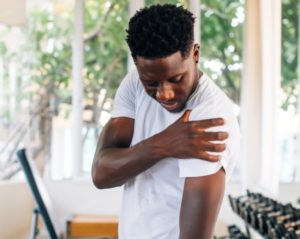You know how it is. You wake up after what you thought was a great night’s sleep only to find your arm in a semi-permanent position above your head. The shoulder pain — ouch!
Slowly, but surely your shoulder loosens and allows your arm to return to a normal position. That same morning you reach for a gallon of milk and find it difficult to put it back up on the shelf. You shake it off to achy joints and head out the door to start your day — after struggling to lift your heavy coat off the hanger.
The joys of shoulder pain. When is too much pain too much? And how does shoulder pain happen in the first place? Like most things in life, there isn’t one easy answer.
Shoulder pain can be caused by repetitive motion, sports, and general overuse. At first, you may notice a limited range of motion or pain with light weights. Your pain may be gradual or happen suddenly after a fall or heavy lifting. Did you know that shoulder injuries are also among the most common work injuries in the country?

Understanding Shoulder Pain
Bursitis. Bursitis is a painful condition stemming from inflammation of one or more bursae (a small sac of fluid that cushions tendons, bones, and muscles). When doing their job, the bursae promote smooth, frictionless movement. Pain from bursitis is generally a dull ache that worsens when using your shoulder.
Arthritis. Shoulders aren’t immune to arthritis. Arthritis results from damage to the cartilage that provides cushioning over the ends of your bones, causing bone-on-bone friction. You may notice a deep ache in the back region of your shoulder. “That deep ache turns into stiffness and limited mobility,” noted Dr. J. Benjamin Smucker, MD, of Orthopedic & Sports Medicine Center (OSMC). “For patients with arthritis, we start with physical therapy and anti-inflammatory over-the-counter medications.”
Shoulder Impingement. Shoulder impingement is a painful and persistent inflammation caused by excessive rubbing of the shoulder muscles against the top portion of the shoulder blade.
Rotator Cuff Tendinitis. One of the most common shoulder injuries is rotator cuff tendinitis. Think of the rotator cuff as a group of four small muscles and tendons that attach the shoulder blade to the upper arm. The rotator cuff muscles allow you to lift and rotate your arm. When these muscles and tendons become inflamed or irritated, movement becomes painful and difficult. You may be suffering from an irritated rotator cuff if you notice a dull ache near the front of your shoulder. This ache gets more intense when you add weight or try to reach overhead.
Rotator Cuff Tear. Tearing of the rotator cuff tendons and muscles is less common than tendinitis. However, a tear, whether partial or full, can cause excruciating shoulder pain. Rotator cuff tears happen by prolonged use or sudden trauma, such as falling or lifting heavyweights.

Adhesive Capsulitis. You know this better as a Frozen Shoulder. A frozen shoulder can happen when the tissue surrounding the shoulder joints contracts and thickens. Your movements become more difficult and sometimes impossible. Think of a frozen shoulder in three parts:
- Freezing: Pain with movement and limited mobility
- Frozen: More stiffness, but less pain
- Thawing: Improvement in both movement and pain
Dislocation. A shoulder becomes dislocated when the top of the upper arm bone comes out of the shoulder socket. Someone’s shoulder may dislocate from a car accident, a fall, or a sports injury.
“A partial dislocation will often slip back into place,” explained Dr. Smucker, “but a complete shoulder dislocation requires a medical evaluation. In younger patients there is a high concern for further dislocations to occur. In older patients we commonly see torn rotator cuff tendons.”
Getting treatment quickly after a complete dislocation is very important.
“A careful exam and an MRI done soon after the dislocation injury is important to helping to determine the best treatment options,” Dr. Smucker said. “Treatment could include physical therapy, surgery and other options, based on your needs and your physician’s recommendations.”
Take care of your shoulders. If you’ve been suffering from shoulder pain that hasn’t improved over time, please contact OSMC at 574-264-0791 and reserve a time to see a shoulder specialist for non-surgical and surgical options to feel better.
This blog post is not intended to provide personal medical advice, professional diagnosis, opinion, treatment to you or to any other individual. It is information for educational purposes only. You should not use this information in place of a consultation or the advice of a healthcare provider.

